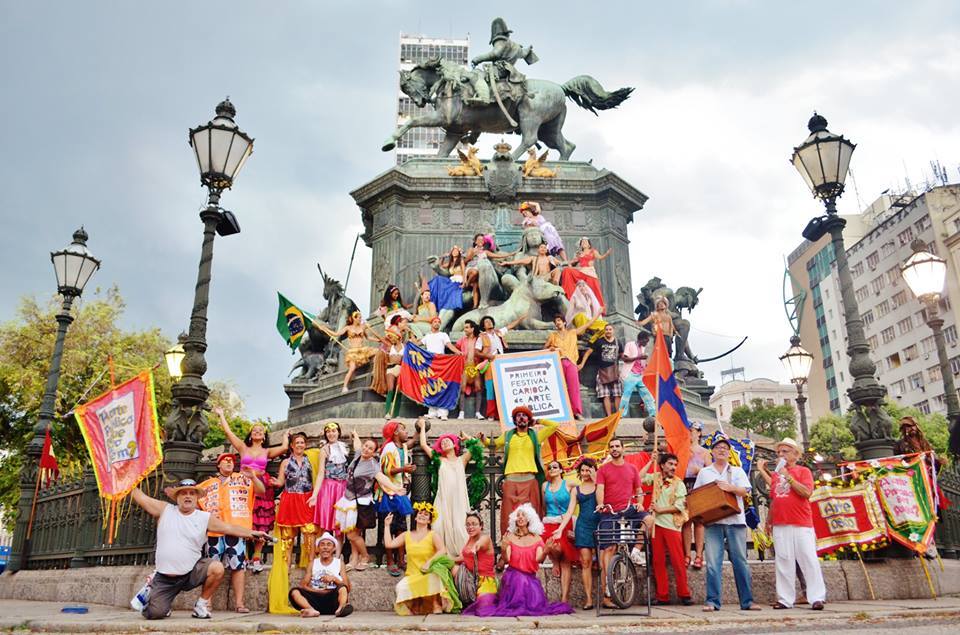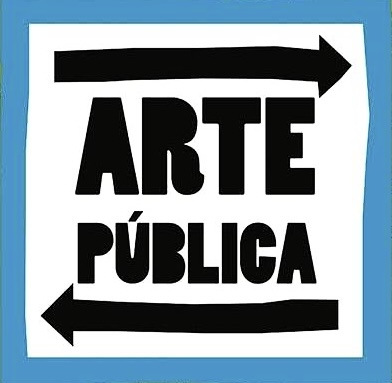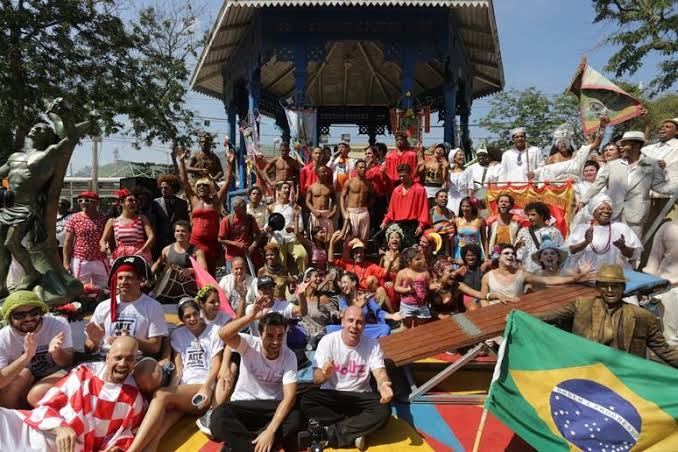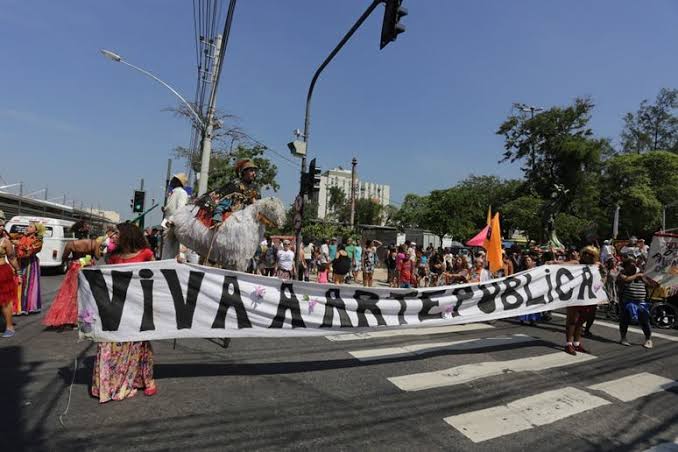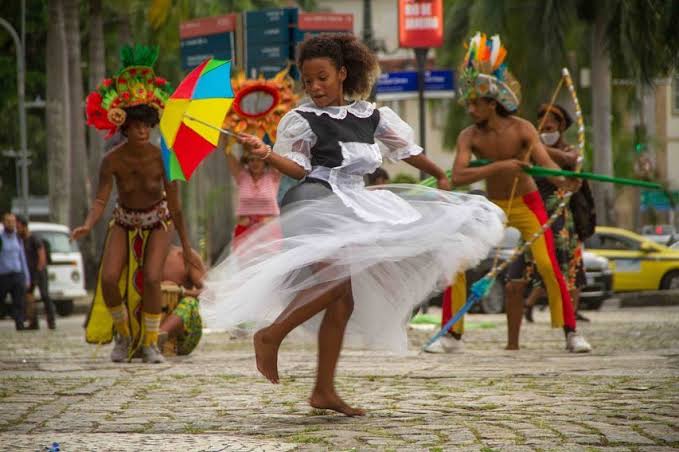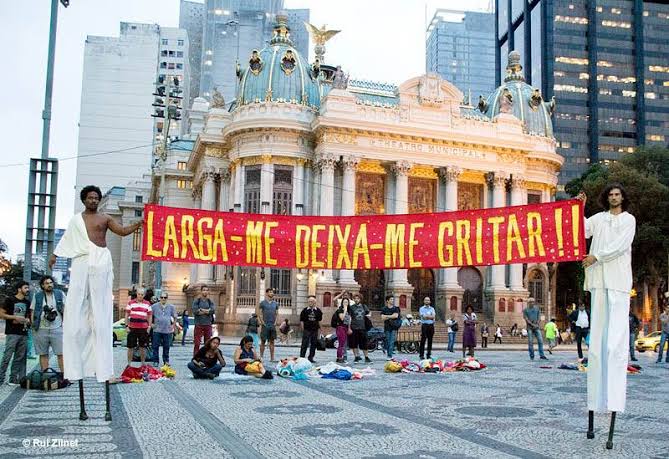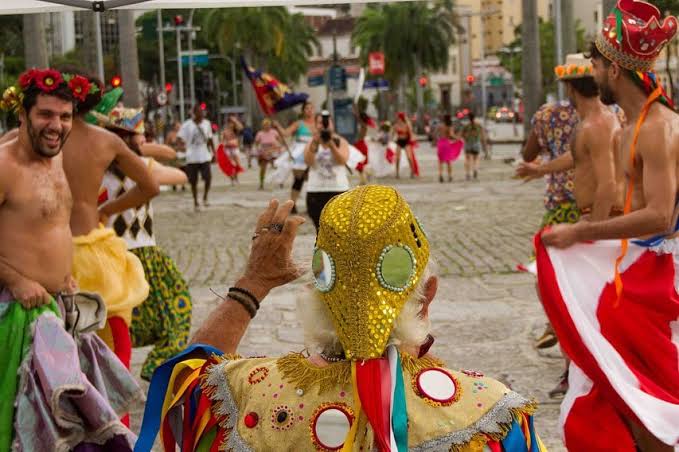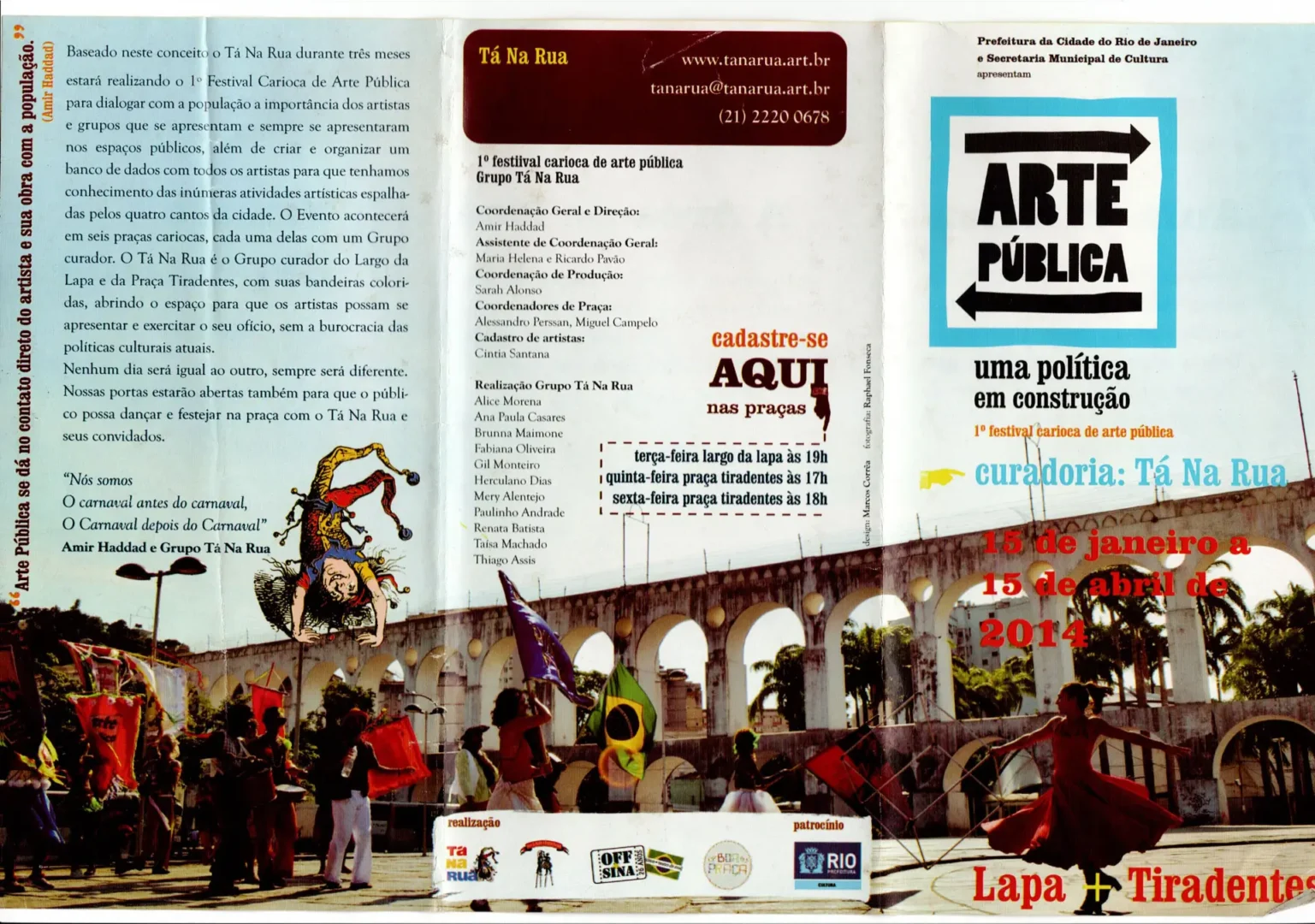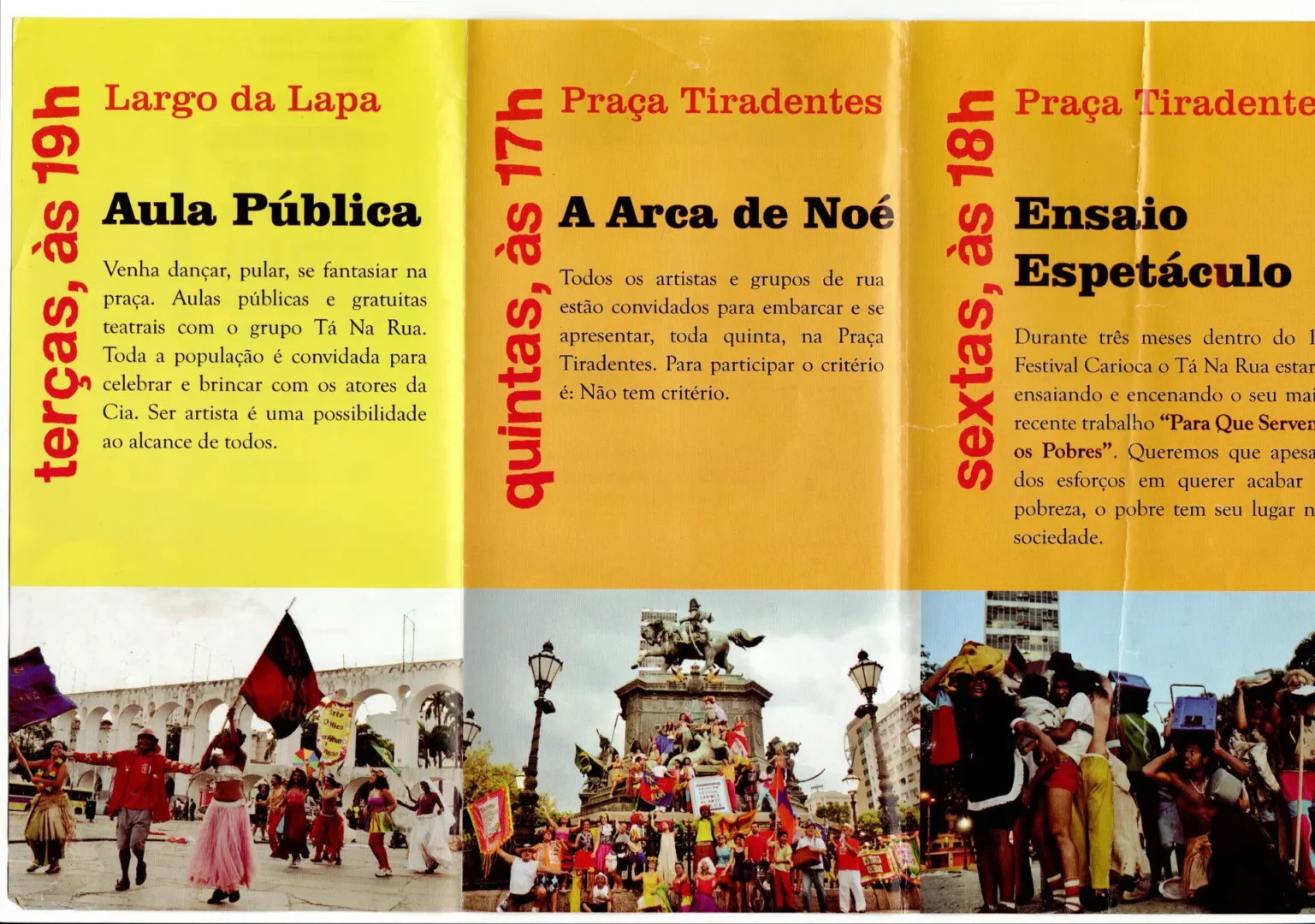Discussions about the issue of public art began in 2010 and 2011 when street artists started to be harshly persecuted by authorities, having their materials confiscated and being prohibited from performing their work. From these events, Amir began developing the concept of public art, meaning an art that is not sold, not bought, and arises from the direct contact of the artist and/or their work with citizens, anywhere and without any form of distinction.
“The concept of public art is still very new and, at the same time, very ancient. It is an art created and produced for everyone, without class distinction or any other form of discrimination, capable of occupying any and all spaces, with the full social function of organizing the world, even if only for moments, rekindling hope within the population. It is a right of every single citizen,” defines Amir Haddad. (Street artists perform in historic squares in Rio until the 14th – Jornal Brasil, n.d. Article on the 3rd Carioca Public Art Festival, produced by the Carioca Public Art Forum, coordinated by Amir Haddad)
- Art has never been anything but public. It only became a market product, thus privatized and belonging to those who can pay for it, in the last 200, at most 300 years. It acquired the characteristic of being accessible to only a few, not only to those with money but also to those with the culture and education to consume such a product. (Amir Haddad takes over the Curitiba Festival with his Public Art – Globo Teatro – 04/04/2017)
- Public art is giving citizens back their potential. We aim to restore art to its nature, one that cannot be bought or sold. It is created through the contact of the artist and their work with the population, without any form of discrimination and in any place. (Amir Haddad takes over the Curitiba Festival with his Public Art – Globo Teatro – 04/04/2017)
- Every human being is capable of this creative, fertile, and fertilizing activity. It is essential for humanity. Those who do not exercise this potential become ill. Public art is a matter of public health, of the citizen’s well-being. What kills you inside can save you outside. What could be a song within you might become a cancer. (Amir Haddad takes over the Curitiba Festival with his Public Art – Globo Teatro – 04/04/2017)
Read More
ANÁRGIRO – (s.m.) “One who does not tolerate money. From the Greek “a(n)” = “not”, “without”, “aversion to” + “árgiro” = “silver”, “money”. It is the epithet given to Saints Cosmas and Damian, because they were doctors who did not charge for their services.” (Informal Dictionary)
The anárgiros destabilize the natural order of things. Jesus Christ was anárgiro. Cosmas and Damian were too.
For the poor, Christ was an angel. For the Jewish church of the time, a demon. Cosmas and Damian, for the sick, were saving angels. For the priests and doctors of the time, they were threatening demons.
Just like all anárgiros. They are destroyers, devastators, and yet they make us realize that the world can be this way, but it can also be another way. They are rebuilders.
If anarchism spreads, the world shatters, but in order not to collapse on itself, the world needs the anárgiros. Those who generously offer to the population their knowledge, their thought, their feelings, and reflections for them to use as they please.
They do not aim for profit. It is a generous donation. It is almost like an irresistible act, an uncontrollable impulse that needs to be performed. In the time that is possible and throughout all time.
It is not a calling, therefore, but a compulsion, from bottom to top and from within to outside.
Many of us know these feelings and sometimes we treat them as demonic and sometimes as angelic. Sometimes as we think of them as the best of ourselves, free, open, extravagant. And sometimes as what we know is the worst in any situation.
Not taking care of oneself. Giving to others what you have best to sell. Unlike the other. Not selling what you have best to give, because it is good for everyone, and if sold, not everyone will be reached or benefited. Or selling so that the source does not run dry and can maintain the flow of knowledge and wisdom production. For whom?
God and the Devil in the land of capital.
Will this be the eternal struggle? Endless? Or is there a place on the planet where this new paradise can recombine with the memory of the other, the lost one?
The issue of anargirism is fundamental. The existence of the anárgiros is fundamental.
Hitler did not make the world move, nor did Stalin. Einstein did, and Gandhi and Galileo.
Who are we? (Amir Haddad)
STREET ARTIST LAW
Municipal Law 5.429/2012 Art. 1 Cultural expressions of Street Artists in public open spaces, such as squares, amphitheaters, plazas, boulevards, do not require prior authorization from municipal public agencies, as long as the listed requirements are observed.
LEARN MORE:
THE MAYOR OF THE CITY OF RIO DE JANEIRO, in the exercise of the powers conferred upon him by the current legislation and CONSIDERING the importance of cultural expressions of street artists for this city, especially the preservation and encouragement of the most diverse and democratic forms of artistic-cultural communication, DECREES:
Art. 1 This Decree regulates Law No. 5.429, of June 5, 2012, which governs the presentation of artists in open public spaces in this Municipality.
Art. 2 For the application of the rules of this Decree, the following definitions are given:
I – “street artist”: a person or group who expresses themselves artistically in open public spaces; and
II – “cultural manifestation”: activities that, among others, refer to theater, dance, capoeira, circus, music, folklore, literature, and poetry.
§ 1 The provisions of this Decree do not apply to the sale of industrialized products.
§ 2 The sale of durable cultural goods, such as CDs, DVDs, books, paintings, and handmade items, is permitted, provided that:
I – they are the result of the artistic manifestation carried out, meaning that, in the case of paintings and handmade pieces, the exhibition must be accompanied by the creation of new works; and
II – the street artist is the creator of the cultural goods exhibited or sold, allowing for the possibility of collective authorship.
Art. 3 It is the responsibility of the Submunicipalities to receive notifications regarding the realization of artistic-cultural manifestations in open public spaces that do not have their own regulations.
§ 1 All communications to the Submunicipalities, as referred to in the “caput”, must be sent with the respective “receipt notice” from the postal service or filed in the appropriate locations.
§ 2 The street artist wishing to perform in open public spaces with their own regulations must obtain prior and express authorization from the respective managers.
§ 3 Exceptionally, the street artist may be prevented from occupying the open public space, provided that the following cases occur, with appropriate justifications and, if applicable, supporting documents:
I – prior communication related to the occupation of the same space, where the street artist will be allowed to choose another location;
II – the existence of an event approved by the Municipality of Rio de Janeiro, where the event space coincides with the space the street artist had communicated about;
III – the existence of a public fair already regulated or routinely held at a given location;
IV – the carrying out of an activity in the space mentioned in the communication that aims to meet public needs, such as conducting works, repairs, rescues, among others.
§ 4 The reasons listed in the previous paragraph are merely examples, and other reasons may exist, provided that they are justified to the street artist, in which case relevant legislation regarding urbanism, landscaping, and other related topics may be invoked, concerning the occupation of public space.
§ 5 The justifications in this article must be provided to the street artist in writing.
§ 6 In the communication referred to in the “caput”, the street artist must indicate the location, time, describe their artistic-cultural manifestation, provide a copy of an official identification with a photo, and, if necessary, also describe the simplified structure to be used in the artistic-cultural manifestation.
Art. 4 Street artists’ cultural manifestations must observe the following:
I – gratuity, with only spontaneous contributions allowed and the exclusive sale of products made by the artists themselves, in accordance with relevant legislation;
II – allow, in accordance with the relevant legislation, the circulation of people and vehicles, as well as access to buildings and residences;
III – use a simplified and appropriate structure for carrying out the artistic manifestation;
IV – use a power source for sound equipment with a maximum power of 30 (thirty) Kvas;
V – last up to 4 (four) hours, limiting, in any case, the duration of artistic manifestations to 10 PM;
VI – display brands only when the artistic manifestation is a result of public funding actions; and
VII – not interfere with the organization of events duly approved by the Municipality, particularly regarding their infrastructure and logistics, such as the mobilization and demobilization of equipment, team movement, structure installation, and organization of ticket lines.
§ 1 The street artist who violates any of the items in this article will initially be notified to adjust their artistic manifestation in accordance with this Decree, and if the violation persists, their activity will be immediately halted, with the possibility of asset seizure.
§ 2 Goods that are used for artistic-cultural activities, such as musical instruments and others, cannot be seized.
Art. 5 The provisions of Decree No. 40.711, of October 8, 2015, which regulated the procedures related to authorization and the realization of events in public and private areas in the Municipality of Rio de Janeiro, through “Rio Mais Fácil Eventos,” does not apply to street artists.
Art. 6 This Decree shall come into force on the date of its publication.
Rio de Janeiro, December 14, 2016 – 452nd Anniversary of the City Foundation.
EDUARDO PAES
Official Gazette of Rio, 15.12.2016
CARIOCA'S FORUM OF PUBLIC ART
The forum, which has been taking place for twelve years every Monday at the Tá Na Rua headquarters, always at 7 PM, is a space for meeting, exchanging experiences, and debating public policies for public arts.
It all started when the municipal guard began prohibiting street artists from performing in public spaces, even using force and confiscating the artists’ work materials, within an operation called “Choque de Ordem,” created by the newly established Public Order Secretariat, which, according to the city hall, aimed to end the “urban disorder in which the city found itself.”
In response, street artist groups gathered and created a movement against the actions taken by the Public Order Secretariat. We started meeting, and we held a major protest at Cinelândia, in front of the City Council. As a result, we succeeded in getting Law 5429 created, which protects street artists and allows them to practice their craft without being disturbed by the municipal guard.
But it wasn’t easy, as the law was initially vetoed by Mayor Eduardo Paes. We protested again, which led the Mayor to want a meeting with the public artists. The meeting was scheduled at the Tá Na Rua house, and he came. The house was full, and after a long conversation, the Mayor himself guaranteed that he would instruct his bench to overturn his veto and have the law sanctioned, and that’s exactly what happened. Amir also reminded that the Mayor had suggested creating a public art grant, to which he immediately said, “No.” “If it’s by grant, the artist won’t make it. If it’s a grant, people who have never worked in the street will win and go to the street. We’re here starting this movement. There’s no way for the artist to get in through a grant.” Then the Mayor suggested that a project be presented for street artists.
PUBLIC ART FESTIVAL
We presented the project and after two years of waiting, the project was finally approved, and we held the 1st Public Art Festival, lasting three months, in six squares of the city of Rio de Janeiro: Largo da Lapa, Praça Tiradentes, Largo do Machado, Praça da Harmonia, in Gamboa, Saens Pena, and Afonso Pena. The project took place, and all Rio de Janeiro’s street artists and groups were invited to perform in these locations.
This project was only possible because it was created by artists who have been performing in public spaces for a long time. The government does not have cultural policies to address public arts. There is no thought on this matter, there is nothing. This project was a result of the movement. It was from the bottom up, from the inside out, not the other way around. It was not created by the Public Authorities. It was created by street artists.
Today, 3 editions of the festival have already been held, and a mapping of a thousand street artists has been completed.
“We are the oldest. We are ancestors. The artists of open spaces have been around for a long time. Theater was born in the street, within a Greek festival in honor of the God Dionysus, when a man named Thespis raised his mask and said he was the god himself and began interpreting him.”
According to Amir Haddad, this is a pioneering and truly Carioca experience. “Rio de Janeiro is leading in this sector. But we still don’t have consistent public policies for the area. Only the Street Artist Law, recently regulated and always disrespected by Public Order agents,” he adds. (Festival de Arte Pública reaches its third edition in Rio de Janeiro. Mariana Pitasse. Brasil de Fato, Nov 8, 2016)
